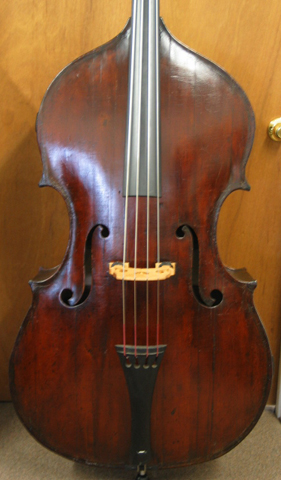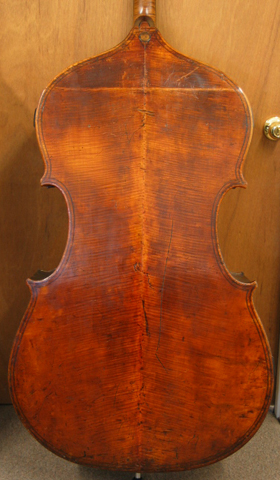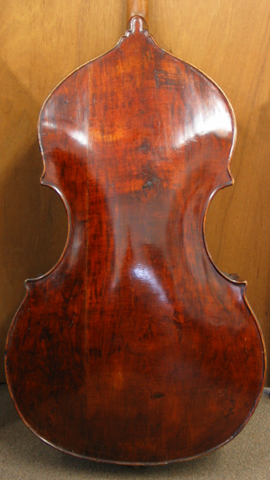
 |
|
|||||||
 |
|
|
Thread Tools | Display Modes |
|
|
|
#1
|
||||
|
||||
|
Quote:
So, what are these things that you go for and stay away from. Also, besides the generic factory basses of the last century, can you estimate the number of Symphony grade classics you have worked on in the last say, 20 years? |
|
#2
|
|||
|
|||
|
Ken, I appreciate you stroking my ever-expanding ego, though my wife would disapprove.
 The main thing I try to stay away from in my building is introducing tension into a bass' corpus. All my basses are a little asymmetrical because after I build the rib structure, I let it relax, and then match the top and back plates to it, rather than doing the opposite, which is more common. I look for good, stable, well-seasoned wood. I stay away from common blunders I see in basses I repair, such as ill-fitting or crooked neck joints, and plates that don't meet the blocks. The workmanship you don't see is more important than what you do see. To answer your second question, I would say a few hundred. |
|
#3
|
||||
|
||||
|
Quote:
 I believe too in the relaxed theory. Wood itself releases tension every time it's cut. I agree that building slow allows the release of the tension as it happens allowing all things to settle down along the way. |
|
#4
|
||||
|
||||
|
I know you are not in favor of Eb Necks but playing my Hart mainly for the last few weeks as well as every other time I can see the advantage personally of the Eb over the D.
I looked over at my stand partner the other day at rehearsal and asked if his was D or Eb? He showed me as we discussed it and he has an Eb as well and does not like the D-necks. I have spoken to other players who feel the same. With my thumb on the Heel my 1st finger plays D (on the G) and my 2nd plays the Eb. I can easily play a C on the E with the 1st and D with the 4th and the same across the Neck. On a D-neck I cant do that without a fairly uncomfortable stretch. Now, on the 'copy' bass the shoulders will be sloped quite a bit more so maybe it wont be as important but I recall the original bass being more of an Eb as well. You can see here the difference in shoulders between the two.   Also, the distance from the top of the Heel to the root of the Neck in the block is much less making the transition into TP so much easier. Look here between the Hart and Martini to see what I am talking about.   Playing the Bass for just a few minutes testing it you will notice other 'feel' issues than the Heel depth but playing 2-3 hour long rehearsals and concerts is another story. I end up thinking about these details on the drive home almost every time. For those of you with experience on both, which do you prefer? We talked about it awhile ago here but the Thread has all but died out.. |
|
#5
|
|||
|
|||
|
My preference is for a D neck, because it's the standard on all string instruments, and because it's stronger. An Eb neck should be installed with less overstand because the heel is much weaker. Also, to do the Eb neck right, you either need a long string length, or you need to build the bass with a short stop. Neither is a good idea, IMHO.
|
|
#6
|
||||
|
||||
|
I also feel more comfortable on the Eb neck. Maybe its because I learned on one, but when ever I play a D neck I need to check my intonation going into TP. Eb its considerably easier.
|
|
#7
|
||||
|
||||
|
Quote:
The Hart if it's overall done unintentionally just happens to be super comfortable and so easy to play up and down and across the strings. The Arch of the Fingerboard (and matching bridge) is also slightly less than the Martini and the flatter arch makes string crossings as well as left hand finger crossings a bit easier once you get used to it. The Martini is such a comfortable bass to play on as it is with the D-Neck. I can only imagine how it would feel with the same Neck and Heel as the Hart. One thing I have noticed is that the Martini has this tall Back Button that is original to the Bass and beautifully carved. The Hart has a tiny Button which helps to allow the smaller Heel. That being said, the Martini Heel at best can only be shaved down to be slightly between a D and an Eb if it were to be altered. I agree the amount of wood and neckstand of the Hart makes it weaker. I look at the bass and I can't figure out how long that Neck has been there. It also looks like the Heel was cut lower at some point but the last repair inscription before I got it was in 1944. The 3-to-4-string conversion must have been sometime in the late 19th or early 20th century or how ever old those Gears are. Like I said, the Shoulder slope is a big part of it. Maybe this new bass will transition just as easy between positions with a D-Neck as does the broader shouldered Hart with the Eb. Comparing the Hart to the Martini (my two favorite basses) you can see as well the shoulder differences. The Martini being smaller but still broad in comparison to the Bass to be copied.     |
|
#8
|
|||
|
|||
|
All good points. Everything depends on the string length, and where the f-holes lay. On some basses, to create an Eb neck, you would have to make the string length 45"!
|
 |
| Currently Active Users Viewing This Thread: 7 (0 members and 7 guests) | |
|
|